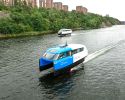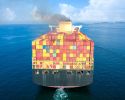Defining the levels of automation

Autonomous maritime ecosystem alliance One Sea has presented a proposal for a scale for determining automation in shipping, by describing six ’levels’ which can be applied to various ship operations or an entire ship.
The international term Maritime Autonomous Surface Ships (MASS) is often associated with self-propelled vessels in media reports. But fully automated unmanned vessels are probably a long way off. Maybe it's not even particularly desirable. In Sweden, we instead use the term smart ships and focus on how new digital technology can contribute to increase efficiency and safety on board.
And the ships are getting smarter. These days, for example, a research project is being completed within the Swedish Transport Administration's industry program Sustainable Shipping, which Lighthouse runs, which has taken a closer look at AI-based decision support systems for navigators on ships. But no matter how well such a system would work, it could not be used in traffic today. Because what happens when artificial intelligence takes over? Who is responsible if an accident occurs? What rules apply?
Autonomous maritime ecosystem alliance One Sea wants to accelerate development so that an international regulatory framework can be implemented. In order for this to be possible, a common terminology is needed. A so-called white paper entitled "Autonomous Ships: Terms of Reference for Rule Development" takes a closer look at definitions and automation levels and explores how they can be applied successively for ship operation.
The paper presents the industry proposal for a scale for determining automation in shipping, by describing six ’levels’ which can be applied to various ship operations or an entire ship.
Level 0: Basic operation / Human controls the vessel
In its simplest form, automation is used to control a process according to set points, which in turn control a variable. A human controls the vessel manually or establishes desired ‘setpoints’ so that automation can achieve the desired outcome. The automated part of functionality is limited to internal monitoring and counteracting deviations between the desired setpoints and received information. This is a closed-loop system.
Level 1: Assisted operations / Hands-on, eyes-on, mind-on
A human operating the ship’s functions assesses and takes decisions based on information received, entering, or adjusting setpoints by way of response. System automation assists the human operator by providing observations/updates and/or automating basic and simple tasks that are logical extensions of decisions made.
Level 2: Partial automation / Hands-off (sometimes), eyes-on, mind-on
The operation of at least one complete function/operational mode is automated. The system informs the human operator of relevant observations and the actions identified as needing to be performed.
Level 3: Conditional automation / Hands-off, eyes-off (sometimes), mind-on
Here too, the operation of at least one full functional/operational mode is automated. When certain operational conditions are fulfilled, the system monitors the process according to the setpoints and automatically takes action to maintain the setpoints. The task may be performed without human control for a limited time..
Level 4: High automation / Hands-off, eyes-off, mind-off (sometimes)
This is the highest level of ‘human-attended’ automation. The functional/operational task is performed to a large extent automatically without human attendance. The system alerts the human operator when intervention is needed if a situation arises when it cannot perform the action within its parameters to achieve the setpoints.
Level 5: Autonomous / Hands-off, eyes-off, mind-off = human-of
Autonomous operations replace all human supervision; human attendance or interventions are not required. The goal set for operations is predetermined but requires autonomous problem solving to deal with situations encountered.
-
 NextWave – en podd som ska locka unga
NextWave – en podd som ska locka unga -
 Ny studie: Eldrivna pendelbåtar kan effektivisera Stockholms kollektivtrafik
Ny studie: Eldrivna pendelbåtar kan effektivisera Stockholms kollektivtrafik -
 Sjöfartens utsläpp ökar
Sjöfartens utsläpp ökar -
 Sociala relationer påverkar val av bränsle
Sociala relationer påverkar val av bränsle -
 Sjöfartens omställning kräver ”mjukare” påtryckningar
Sjöfartens omställning kräver ”mjukare” påtryckningar -
 Hon hade avtalad tid med Kapten ynkrygg
Hon hade avtalad tid med Kapten ynkrygg -
 Lighthouse omvärldsanalys 2025 – osäkerhet och tullar präglar sjöfarten
Lighthouse omvärldsanalys 2025 – osäkerhet och tullar präglar sjöfarten -
 Se seminariet Shipping in the Marine Environment
Se seminariet Shipping in the Marine Environment -
 Vad betyder egentligen de 90 procenten?
Vad betyder egentligen de 90 procenten? -
 Hålla där...
Hålla där...

